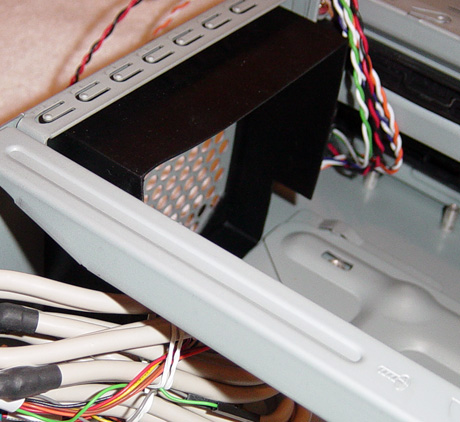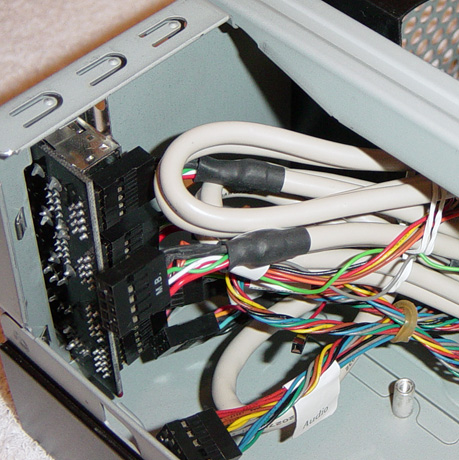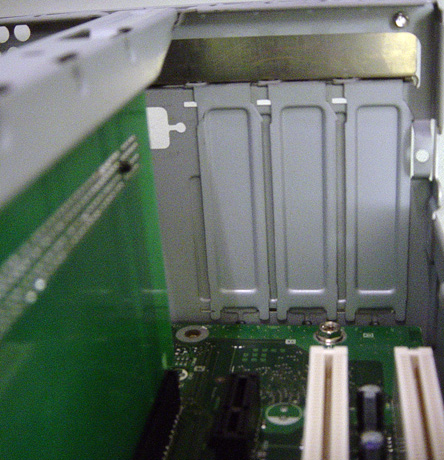Intel's Long Awaited BTX Form Factor
by Purav Sanghani on November 15, 2004 5:31 AM EST- Posted in
- Cases/Cooling/PSUs
First Look: AOpen B300 BTX case cont'd
Internal Design cont'dAt the front of the case is a rubber surround which the thermal module will fit into to provide insulation and to keep warm air from seeping back into the case. To the left of that we see a support bar which spans the depth of the B300 from front to back. As we will see later this bar provides support not only for the structure of the case, but also to hold the PCIe riser card in place. To remove this bar there is a screw at the front of the case that needs to be removed. We then lift the bar from the front, pivoting the backside in its slot and pull up.

Click to Enlarge
To the left of the bar is the auxiliary port module which is home to the internal USB, audio, and FireWire connections. This module is designed with headers so unused ports can be unplugged from the inside to reduce clutter. We also notice that the front panel connections (power/reset buttons, power/HDD activity lights) are also grouped into a single plug to make things easier. It looks like motherboard and case manufacturers are finally working together to standardize more than just the location of the CPU.

Click to Enlarge
The backside of the case consists of 3 vertical half height expansion slots and one full height slot which is positioned horizontally. This, we can safely assume, is where the PCIe x16 VGA card will reside. The I/O backplate is positioned beneath this full length slot.

Click to Enlarge
To secure expansion cards in place there are devices in place on the outside of the B300. Each device, one for the single PCIe x16 slot and one for the other three expansion slots, can be undone by removing a single screw and then pivoting them off the cards' brackets. This feature reduces the number of screws needed but, unfortunately, does not make it a tool-less feature.

Click to Enlarge
Installation
Installing the motherboard was simple since there wasn't much to get in the way if it. We placed the D915GMH on the stand-offs and applied the included screws. We did notice that the tool-less optical mounting device on the inside of the drive bay could not be opened once the motherboard was in place. Luckily the lower HDD bay can be removed by undoing a single screw and sliding the bay back towards the power supply.

Click to Enlarge
There was still an issue with those tool-less devices interfering with the thermal module's fan power header on the motherboard. Unless we plugged in the power cable before replacing the drive bay, it would not stay in place on the motherboard header. We again would need to remove the HDD bay to plug the cable back into the motherboard.

Click to Enlarge
Besides those issues all other parts of the installation carried on smoothly. Our optical drive installed without a hitch since there was nothing to get in the way of the tool-less mounting devices. However, we ran into a clutter problem with the cabling behing the drive bays. As we mentioned earlier the 3 inches of clearance was just not enough to work freely with drive cables, and if it weren't for SATA, there would have been no way to run an IDE ribbon cable to the IDE header on the motherboard. For those that only have the IDE option, we suggest sticking with rounded cables if dealing with this combination of hardware.










77 Comments
View All Comments
stephenbrooks - Monday, November 15, 2004 - link
Do you think if you connect the power to the fans the other way around you can get air to flow in from the front and come out of the back instead?SolarWind - Monday, November 15, 2004 - link
Actually, I like how they moved the processor towards the front of the case. This way the processor isn't in the path of hot air rising from the video card.Also, having the video card flipped over means that high performance heat sinks on the video card won't block a PCI/PCI Express slot.
DeeTees - Monday, November 15, 2004 - link
Your right, I would have sworn that I saw that mess inside of a Packard-Bell. At least they have not yet started using custom fasteners that you need a special tool to replace or upgrade components. (?)quanta - Monday, November 15, 2004 - link
BTX may deliver overall cooler temperature per volume of space, but what about all the hot air that was used to cool the CPU? Wouldn't the hot exhaust cook the video card and bridge controller, limiting overclocking potentials? Temperature aside, having air intake in front of the case reduces usable drive spaces that would be used for fan controllers. If I were designing BTX, I would put CPU on top corner, and a curved 'casing' that would route exhaust to top blowhole.PuravSanghani - Monday, November 15, 2004 - link
#42: Actually it us just these micrBTX cases that do not have rear exhausts...so far. We may see case manufacturers employing case fans as soon as BTX becomes a mainstream form factor.At Computex this past year, we did see some companies like Enlight (http://www.anandtech.com/casecooling/showdoc.aspx?... show off some mid tower cases which did have room to add extra case fans. We still have a lot to look forward to concerning the new form factor.
skunkbuster - Monday, November 15, 2004 - link
it would have been nice to have a rear exhaust...bob661 - Monday, November 15, 2004 - link
Man those P4's sure do run hot. 63C WITH the BTX case. My A64 runs at 36C inside the ancient ATX case. I'm still running the OEM CPU cooler and oh about 6 case fans. :-)Cygni - Monday, November 15, 2004 - link
Looks like BTX is going to work out for Dell and HP... but I dont think its going to have much effect for the enthusiast and self built markets. Seems to me that its going to be at its best in mBTX situations, but full BTX seems ho-hum. I guess its just more crap i gotta buy next time i upgrade. BTX mobo, BTX case, DDR2, SATA HD, PCI-Ex video card, new CPU... they really havent left anything for me to KEEP during a P4 to P4 upgrade. Me no likey.vedin - Monday, November 15, 2004 - link
Where am I supposed to put a window and neon light in that case? Hmm?Spinne - Monday, November 15, 2004 - link
I don't see what the problem is with BTX cases. The design layout, atleast for Intel processors makes a lot of sense as far as thermal regulation goes. Channeled airflow on ATX cases is a niche market, and the fact that there are no standards means that you can't be assured of compatibilty across motherboard solutions. You really don't want to have spent money on a new mobo and case only to find that a lousy capacitor prevents you from using channeled airflow. Also, there's no reason why a manufacturer can't place additional fans in a BTX case to cool the case further. Remember, cases are not upgraded as regularly as the actual hardware, so one always has the option of moving to BTX at one's lesuire. I dunno about you guys, but I live in a college dorm, and the smaller my case footprint is, the happier I am, especially if it's a full form-factor case.